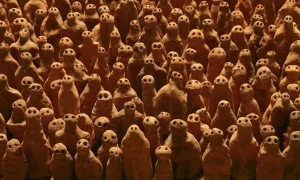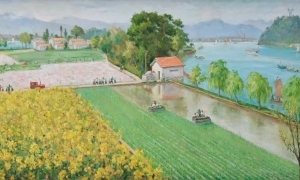不在场的叙述
黄 亚纪
自笛卡尔(René Descartes)开始,西方哲学对于绘画再现的讨论主要在于,绘画让所绘物之存在及其扩延性之再现得以可能,即使到了印象派,塞尚(Cézanne)追求绘画的深度,经过破除事物表皮成为相称于实证经验的自我临现,论点仍立基于外在世界的他者的存在,经过不同的艺术方法达到追问存在的意义。相较之下,罗荃木的绘画,自其山水到标本系列、或采蝶人(2007)、伐木人(2007)、采石(2008),这些似写生而来的景物其实来自艺术家记忆的拼凑,是从心中理想的历史得到具体意像,并转变为充满情绪流露的所在。
最初认为罗荃木的绘画和看的方法有关,早期的地图(2000)、天安门(2000),或是山水(2002)、(2006),皆是将西方对于路径和地形的认知,以带有科学分析的手法在画布中延展开来,尤其是溢满整个画面的山水,是解剖中国山水画的笔法,似乎将郭熙山水的一角如地图般摊平审视;但之后,罗荃木的山石却又自满出的山水开始缩小,变成游离在空间中的一段景致,接着又幻化成与画中鹿、孔雀相伴之石,或是喷泉巨石,即「宣和画谱」中所说:「云烟变灭庵霭之间,千态万状」,生机处处,为可栖、可居、可游的神奇,是中国山水画中所描述万物和自然之关系。
罗荃木对山石的想法表现了对艺术的追求,作品既自由又抑郁,即同其述:「山石是介于抽象和具象之间的形象,可以按照内心的感觉自由行走,在任何地方多一点或少一点,不被形所限制,山石的型态有点像心灵的地图,布满奇怪的洞穴,它的肌里几乎是神经质的」。罗荃木对于山石描写的整段过程,并不像西方艺术家的态度在于形体的释放,相反地,罗荃木紧缩形体,让曾经暴露出全部的肌里纹路重新蜷起,存在于灰暗空间,周边景色萧条,孤立于艺术家极个人的次元,这个次元且被紧紧隔离于画面中,看不到存在于外部世界的可能,亦看不到过去未来;尽管生物居于其中,却闻不到生命的现在性-罗荃木的绘画是对于过往的一个切片,一个幻觉,一个梦境的假设。
这也就不难解释罗荃木对于标本的偏好,并将场景直接地自博物陈列中撷取,这拼凑自艺术家记忆或相片的过程正如将摊平剖析过后再度构造出的山石,成为了只存在于画布中某个过去的瞬间;但有趣的是,这些标本都存在着一种自在,这份感觉是无法在杉本博司(Sugimoto Hiroshi )摄影中看到-此可呼应宋时以写生观察自然、寄情自然的文人思维,但罗荃木经过记忆和照片的造景和宋人走访山林、秘观花木鸟兽的写生不同-罗荃木居住于城市里,存活在当下,却对过去已不存在之物写生,是极度个人内面情感反射,且自在地、不悲愤地、却也忧郁地认同自我和外在的这个状态。
在采蝶人、伐木人、采石中,罗荃木积垒的细节渐渐改变,采蝶人、伐木人满溢的背景企图将犹有空缺的过往性填满,肌里经营视觉交缠,拉开空间的确定感,光线、色彩创造理想世界的地方感和故事性,捕捉某种即将结束或即将开始的模糊状态,这种状态感是罗荃木作品中独有的气息,他发现了普世所固定下来的东西的之间或之后,某些事物和情绪被指涉、被暗含,却也不能说清的神秘;采石和山石(2007)中,罗荃木将过去似范宽堂堂大山的主轴构图转为略偏一方,充满变化型态,细碎皴擦丰富了山形又提供了一种秩序感。山石展现罗荃木以白色表现质面的特定笔法,流露写意的冬日气质,未被冻结的垂瀑水池引着视觉走向后景,S型水畔让视线贯穿画面的同时被左右风光吸引,又像幼时探索未知地般小心冒险。
一切都在加快,这是世界的写照,过去十年如此,未来十年亦会如此,整个世界不断从身旁飞奔而过,罗荃木却在这喧嚣中安静圈出不曾流动的那一刻,他让观者喜爱上进入另一个世界,喜爱上神秘难解的事物,让我们进入故事里,然后越来越深入,感受到神奇,事情开始浮现,在结局处终于见到艺术家指出的人文或表达的那个开始。
narration of absence
Yaji Huang Chieh Jane Anderson-Wu
Since the time of René Descartes the debates upon representational painting have been focused on the possibilities of extended existence or representation of objects depicted by artists. Impressionist artist Paul Cézanne pursued depth of tableau through breaking away from the appearance of things and representing the scenes with subjective perception—an idea from positivism. All these arguments are, however, based on an assumption that there are Others existing in the outside world and the significance of their existence won't be understood except through diversified art forms. In Luo Quanmu's paintings, from landscape to specimens such as "Butterfly Catcher"(2007), "The Logger"(2007), and "Rock Collector"(2008), the seemingly realistic scenes are in fact composed of memorial collages of the artist. The materials in these collages are retrieved from an ideal history fabricated by Lou, and before being transformed into concrete images, they are permeated with the artist's emotions.
Lou's early paintings revealed the angles of the viewer's gaze. The "Map"(2000), "Tiananmen Square"(2000) and two "Shanshui "(2002), (2006) unfold topological features on canvases with western scientific perception and methodology. Nevertheless the brimming landscape comes from a dissection of traditional Chinese landscapes-- it seems that a fragment of Guo Xi's work has been flattened to be scrutinized like a map. In Lou's later works, mountain rocks apparently have shrunken from the excessive landscapes, becoming an image drifting in space. In other paintings, the mountain rocks are replaced by stones beside deer or peacocks, or fountain megaliths. Like what the Xuanhe Painting Guide has pointed out: "Haze shifts among the cloudy sky over the roof of a Buddhist convent, its forms are ever-changing." In Chinese paintings, the most prominent delineation of the relationship between men and nature is the livable, playable and restful environment.
The changing rocks are the embodiment of Lou Quanmu's art:seemingly carefree but intrinsically restrained. In a statement Lou said:
"Mountain rocks possess forms that are both abstract and figurative, their shapes are paralleled to our mental topology, and their apertured, coarse textures are like our nerves."
Contrary to the western artists who tend to liberate objects from their forms, Lou's mountain rocks are contracted, and their once exposed textures and grains now curl up. Arranged in the somber, desolate surroundings, these rocks are confined in the artist's personal dimension, a dimension absolutely isolated in the painting, a dimension without any connection to the outside world or the future. Despite the existence of lives in this dimension, the audience is not able to feel any of their presence. Lou's painting is a section of the past, an illusion and a dream.
That might explain why Lou is enchanted by specimen. He staged a scene of a museum that displays the pieces of his memories and mental pictures through the laying out and reconstituting the cross-sections of rocks. The procedures only exist in a momentary flash on the canvas. Though there are similarities between Lou's themes and those of Japanese photographer Sugimoto Hiroshi, Lou's objects are at greater ease than Hiroshi's. Like to the literati from the Song Dynasty, nature is the anchor for Lou, only literati in the old time depicted mountains, woods, birds and flowers through visiting and touching them personally. Lou, a city dweller, can only piece up the past objects with the present conditions. Lou's works reflect his personal emotions and he candidly identifies such emotions with sentiment.
In "Butterfly Catcher", "The Logger", and "Rock Collector”, Lou gradually changed the excessive details. The saturated backdrops of the "Butterfly Catcher" and "The Logger" attempt to fill up the waning past; the artist created a place and a story in an ideal world through mingled textures, entangled prospects and a certainty in the unfolding space, light and colors. Lou grasps the ambiguous status of something about to set out or about to end. Such a fashion is his unique style because he has found the myth in things and in emotions that can't be represented no matter how they are depicted or implied.
In "Rock Collector” and "Shanshi"(2007), the grand mountains comparable to Fan Kuan's have been moved slightly to one side, the capricious configurations and the rugged hills nonetheless give out a sense of order. The white rocks demonstrate Lou's brushwork that presents a wintry feel, and the running waterfall leads viewers toward the background where an S-shape pond transverses the canvas from left to right. Seeing this picture, a cautious adventure we've conducted in childhood has been revitalized.
Over the past decade the world is moving faster than it ever has and in the next decade it surely won't slow down. Things are flying by as Lou Quanmu is grasping the still, tranquil moments among all the bustling incidents. Looking at his paintings, the audience can not help themselves but fall into the world of mythic ambience he created. We enter it, feel it as these intriguing things emerge gradually, and at length, we realize what the artist tried to show us.
【编辑:贾娴静】





















